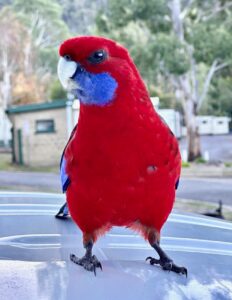
My phone’s new Home Screen photo, a Crimson Rosella (Paltycercus elegans). ©Craig Thomas
June 2, 2024
I’m not a birder. On hikes I usually forget my binoculars, and when I do have them, I dislike them banging against my chest while walking. Nor do I enjoy standing still for long minutes gazing at rustling leaves. But I do love birds and that’s one reason I enjoy visiting Australia. The birds there get right in your face.
Craig and I spent most of May driving a rented camper around southeast Australia. Our first stop was a friend-of-a-friend’s charming wildlife rescue farm near Rylstone, New South Wales. As we pulled into the driveway, Ernie the emu welcomed us with open—well, dangling—wings. Emus are flightless, their nonfunctional wings only 8-inches long.
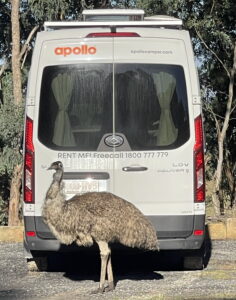
Ernie’s two tiny wings hang at his sides ahead of his legs. The Emu, Dromaius novaehollandiae, is native only to Australia. Males exclusively incubate the 5-to-15 eggs and take care of the chicks. ©Susan Scott
Hand-raised from a hatchling by the animal-loving farm owners, this six-year-old emu makes soft boom sounds as he pads around on his dinosaur feet, poking his head into whatever sparks his curiosity. Our camper fascinated Ernie and he seemed eager to help Craig and Grant fix a jammed step (photos below.) Holly thought Ernie would be a good model for Apollo Camper ads.
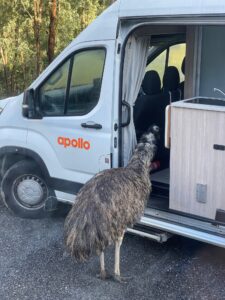
.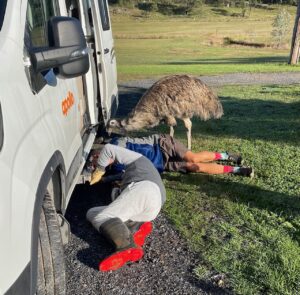
Although I hated leaving Ernie (the bird of my dreams—large, lovable, and unmistakable) as well as Holly, Grant, their kangaroos, and other rescue animals, we soon left to explore more of Australia’s endless wonders.
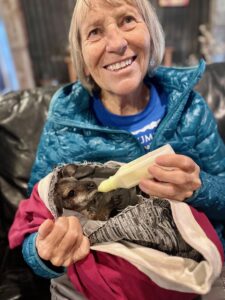
Holly and Grant let me feed Roy, a rescued red-neck wallaby joey.
At a caravan park in Victoria, I jumped out to check the van’s clearance and gave Craig the thumbs up to drive forward. Crunch!
Oops. I had not seen the rooftop TV antenna, a disc that now dangled from its wires over the van’s side. Park managers lent us tape and a ladder, and Craig climbed up for a makeshift repair.
“Susan,” he breathed from the ladder top. “A gorgeous bird just landed. It’s standing here watching me.”
When I reminded him that the van was too tall for me to see the top, Craig drew his phone from his pocket and took pictures, the bird turning its head this way and that, as if posing. Then bored with the situation, it flew off.
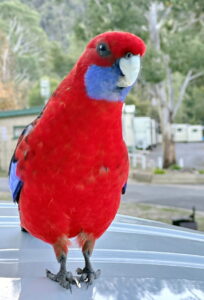
This is a Crimson Rosella, a parrot common in the area. We have yet to learn what the company will charge for the broken antenna, but whatever the cost, it’s worth it. Each time I reach for my phone, Rosie-the-repair-supervisor lights up my Home Screen and makes me smile.
Even tiny birds hop around your feet in Australia. While walking in a native botanical garden in Victoria’s Grampians National Park, several LBBs (little brown birds) appeared before us, blending in so well with fallen Eucalyptus leaves we could barely make them out. Those were the females. When the male of the group landed nearby, we grabbed our cameras.
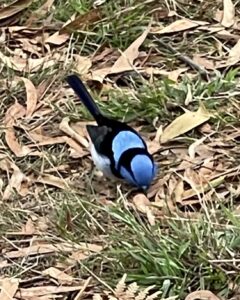
This the Superb Fairywren male, another species common in the area. The females nearly matched the ground cover.
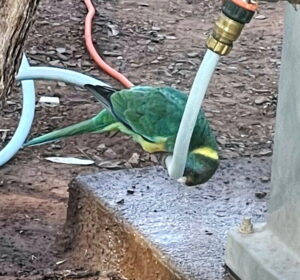
Australian Ringnecks, members of the parrot family, graced our campground with their presence in Ikara-Flinder Ranges National Park, South Australia. This one drank water from a leaky hose fitting. ©Susan Scott
Because I’m president of the Hawaiʻi Audubon Society, people are often surprised that I’m not a birder. But I am an ardent admirer. Bird songs lift my spirits, I view feathers as works of art, consider nests architectural miracles, and never cease to marvel over birds’ colors, shapes, and behaviors.
For that, I don’t need binoculars.
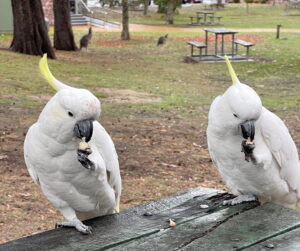
Sulfur-crested Cockatoos are common throughout east Australia. Residents often consider these parrots pests, but I was thrilled by their appearance. These two cockatoos shared a national park picnic area with a friendly mob of kangaroos, two standing in the background. ©Susan Scott